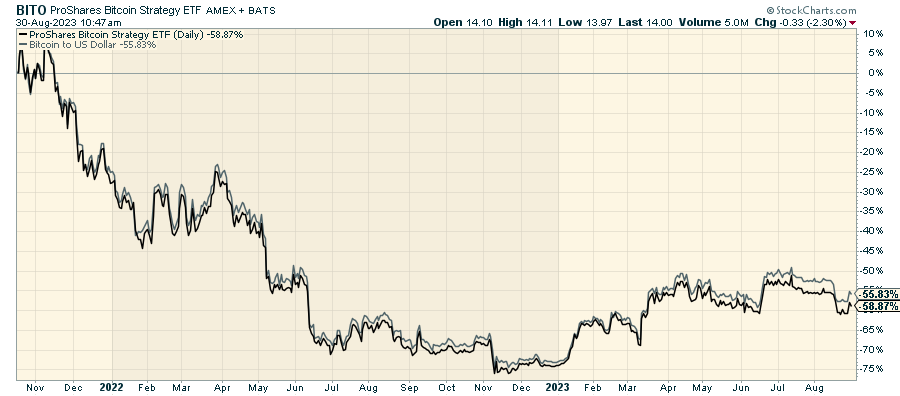After The Grayscale/SEC Ruling, Bitcoin Futures ETFs Still Have Value
A spot bitcoin ETF isn't on the way yet, but its chances just improved.
Yesterday, the ruling from the U.S. Circuit Court of Appeals in the District of Columbia threw out the SEC’s rejection of Grayscale’s application to convert the Grayscale Bitcoin Trust (GBTC) into an ETF. The decision concluded that the SEC acted unevenly in approving bitcoin futures ETFs while, at the same time, rejecting spot bitcoin ETFs. It’s a decision that market watchers have been eyeing for months and one that marks a big leap forward for the eventual approval of a spot bitcoin ETF.
What does it mean in the near-term? Well, not much really. This ruling doesn’t mean that a spot bitcoin ETF has been approved, nor does it mean that such an approval is imminent. It effectively means that the SEC is going to need to come up with another reason for rejecting spot bitcoin ETFs. The application to convert GBTC to an ETF is still outstanding and still needs to be approved. That process could still take months before such a product actually launches.
The good news is that if you’re an ETF investor and you don’t want to deal with the hassle or the uncertainty involved in opening a crypto wallet and trading coins directly, there’s still a good option. That would be the bitcoin futures ETFs that the SEC has already approved.
Bitcoin Futures ETFs vs. Spot Bitcoin
To lay a little groundwork, bitcoin futures ETFs are pretty much what they sound like. Instead of investing in “physical” bitcoin, they invest in futures contracts based on the price of bitcoin, much in the same way that gold, oil or commodities ETFs do.
The downside of futures-based ETFs is that you need to continue rolling over into new contracts with future expiration dates regularly. In a lot of cases, that’s done on a monthly basis and comes with a cost. The result is a drag on the fund’s price that usually ends up producing lagging performance relative to the underlying security. The thought with bitcoin futures ETFs is that because the underlying security is so volatile, the roll cost associated with them would be higher and the drag would be greater.
But that really hasn’t been the case so far. If we look at the ProShares Bitcoin Strategy ETF (BITO) since its inception in late 2021, it’s only narrowly trailed the performance of spot bitcoin over the past nearly two years.
When the fund originally came out, people were worried that the drag might be as much as 10% annually. Trailing the underlying security by just 3% over BITO’s life has been a huge win for investors. The closer it can track its underlying, the better the fund is.
And that makes bitcoin futures ETFs a very viable alternative to the as-of-yet non-existent spot bitcoin ETF. That’s not to say that they’re the perfect, but I think they’ve turned out to be a better product that some originally thought they’d be.
And they certainly make a better choice for bitcoin exposure than GBTC. That product behaves like a closed-end fund, which means it can trade completely independently to the actual value of its bitcoin holdings. Historically, that premium/discount to GBTC’s NAV has been huge.
Over its life, GBTC has traded anywhere from a nearly 100% premium to bitcoin’s price and a 50% discount. That huge range has meant that GBTC has been a very poor proxy for bitcoin exposure even though it’s a bitcoin trust. Today, it’s still trading at about a 20% discount. The tight link to bitcoin’s price is what makes bitcoin futures ETFs the much better option.
Bitcoin Futures ETFs
Between long, short and leveraged strategies, there are 7 bitcoin futures ETFs according to the ETF Action database.
The biggest, by far, is BITO, which also had the advantage of being the first to market. The VanEck Bitcoin Strategy ETF (XBTF), the Valkyrie Bitcoin Strategy ETF (BTF) and the Hashdex Bitcoin Futures ETF (DEFI) essentially utilize the same strategy. The Bitwise Bitcoin Strategy Optimum Roll ETF (BITC) is slightly different in that it actively manages which contracts it rolls into to find the highest implied roll yield, but its correlation to the other ETFs listed is still virtually 100%.
In my ETF rankings for this group, BITO lands at #1 based on greater liquidity and that’s probably the one to choose here if you were considering one of these funds even though XBTF has performed a little better. XBTF is also the cheapest in this group, so it’s a close #2.
What Happens If A Spot Bitcoin ETF Is Approved?
If/when a spot bitcoin ETF is approved, it probably makes the bitcoin futures ETFs unnecessary. Investors will likely prefer an ETF based on an asset over one that invests in futures contracts based on the asset. As I noted yesterday over on TheStreet, there will probably be a chunk of assets in the futures ETFs that stay there just because people invest and then forget, but I suspect some of the smaller funds will be at risk of closing. Spot bitcoin ETF assets probably pick up very quickly after a fund is launched.
But that day isn’t today. A spot bitcoin ETF is probably still months away. In the meantime, bitcoin futures ETFs make a more than adequate alternative.







